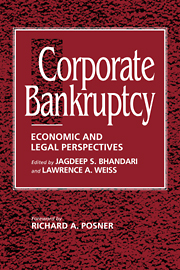Book contents
- Frontmatter
- Contents
- List of tables and figures
- Foreword by the HONORABLE RICHARD A. POSNER
- Preface
- Part I The role of credit
- Part II Bankruptcy as a reflection of the creditors' implicit bargain
- Part III Beyond the basic creditors' bargain
- Part IV Workouts or bargaining in the shadow of bankruptcy
- Part V Alternatives to bankruptcy and the creditors' bargain
- 21 Corporate control and the politics of finance
- 22 The uneasy case for corporate reorganizations
- 23 Bankruptcy and debt: A new model for corporate reorganization
- 24 A new approach to corporate reorganizations
- 25 Debtor's choice: A menu approach to corporate bankruptcy
- 26 Is corporate bankruptcy efficient?
- 27 The voting prohibition in bond workouts
- 28 Financial and political theories of American corporate bankruptcy
- Part VI Experience of other countries
- Index
21 - Corporate control and the politics of finance
Published online by Cambridge University Press: 10 December 2009
- Frontmatter
- Contents
- List of tables and figures
- Foreword by the HONORABLE RICHARD A. POSNER
- Preface
- Part I The role of credit
- Part II Bankruptcy as a reflection of the creditors' implicit bargain
- Part III Beyond the basic creditors' bargain
- Part IV Workouts or bargaining in the shadow of bankruptcy
- Part V Alternatives to bankruptcy and the creditors' bargain
- 21 Corporate control and the politics of finance
- 22 The uneasy case for corporate reorganizations
- 23 Bankruptcy and debt: A new model for corporate reorganization
- 24 A new approach to corporate reorganizations
- 25 Debtor's choice: A menu approach to corporate bankruptcy
- 26 Is corporate bankruptcy efficient?
- 27 The voting prohibition in bond workouts
- 28 Financial and political theories of American corporate bankruptcy
- Part VI Experience of other countries
- Index
Summary
Our political, regulatory, and legal system has produced a set of policy changes that are frustrating instead of encouraging the normal market adjustment process that was underway in 1989. Indeed, from an economist's perspective, such changes seem virtually the opposite of what is necessary to promote the efficient reorganization of troubled companies, an expansion in the availability of debt capital, and a general return to growth. By drying up traditional credit sources, regulation has sharply increased the cost of debt and thus increased the number of defaults. At the same time, other changes have interfered with the private workout process, thus ensuring that many of those defaults will turn into bankruptcies. All this might not be so troubling, except that the rulings and practices of our bankruptcy courts are making the Chapter 11 process seemingly ever more costly, adding to the waste of resources.
A Proposal for Reforming the Bankruptcy Process
The function of the bankruptcy courts is to enforce contracts between the firm and its creditors, and to provide a formal process for breaking such contracts when they cannot be fulfilled, and when private parties cannot resolve their conflicts outside of court. In addition, bankruptcy courts resolve ambiguities about the size, legitimacy, and priority of claims. Unfortunately, the U.S. bankruptcy system seems to be fundamentally flawed. It is expensive, it exacerbates conflicts among different classes of creditors, and it often takes years to resolve individual cases. As a result of such delays, much of the operating value of businesses can be destroyed.
- Type
- Chapter
- Information
- Corporate BankruptcyEconomic and Legal Perspectives, pp. 329 - 335Publisher: Cambridge University PressPrint publication year: 1996
- 2
- Cited by



